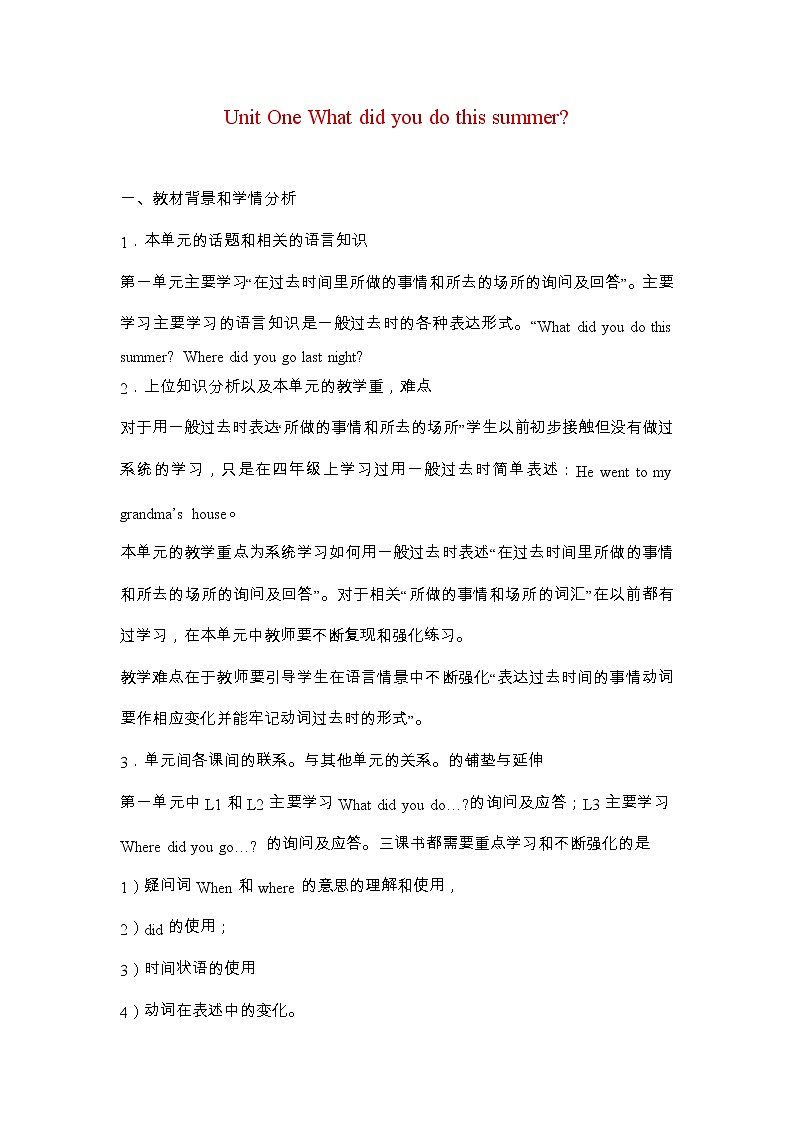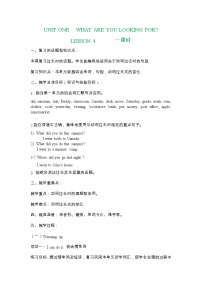


所属成套资源:北京版英语六年级上册教案全套
北京版六年级上册Lesson 1优质课教案设计
展开
这是一份北京版六年级上册Lesson 1优质课教案设计,共15页。教案主要包含了教材背景和学情分析,本单元具体教学目标,本单元具体课时安排,教具准备,教学过程,板书设计,课后反思等内容,欢迎下载使用。
Unit One What did you do this summer? 一、教材背景和学情分析1.本单元的话题和相关的语言知识第一单元主要学习“在过去时间里所做的事情和所去的场所的询问及回答”。主要学习主要学习的语言知识是一般过去时的各种表达形式。“What did you do this summer? Where did you go last night?2.上位知识分析以及本单元的教学重,难点对于用一般过去时表达“所做的事情和所去的场所”学生以前初步接触但没有做过系统的学习,只是在四年级上学习过用一般过去时简单表述:He went to my grandma’s house。本单元的教学重点为系统学习如何用一般过去时表述“在过去时间里所做的事情和所去的场所的询问及回答”。对于相关“所做的事情和场所的词汇”在以前都有过学习,在本单元中教师要不断复现和强化练习。教学难点在于教师要引导学生在语言情景中不断强化“表达过去时间的事情动词要作相应变化并能牢记动词过去时的形式”。3.单元间各课间的联系。与其他单元的关系。的铺垫与延伸第一单元中L1和L2主要学习What did you do…?的询问及应答;L3主要学习Where did you go…? 的询问及应答。三课书都需要重点学习和不断强化的是1)疑问词When和where的意思的理解和使用,2)did的使用;3)时间状语的使用4)动词在表述中的变化。4.本单元知识点、考点的梳理1) 功能句What did you do this summer?I went back to Canada/ a summer camp.What did you do this summer?I went to a summer camp.Where did you go last night?I went to Sara’s house. 2). 课文中的重点句子I went to a park with girls in Grade 5.We swam in the sea.We washed our own clothes.We learn to cook.We made a birthday card for her mom.So you had a lot of fun.2) 能就What did you do …? Where did you go ….?进行问答。3)疑问词When和where的意思的理解和在句中使用。4)did的使用。能在对话中使用Did you/he/she /they…? Yes, I/he/she did. NO, I didn’t.5)时间状语的使用;(last Monday----last Sunday ;yesterday evening-yesterday afternoon)6)动词在表述中的变化。clean-cleaned go-went put-putmove-moved do-did read-readvisit-visited take-tookstay-stayed spend-spentlearn-learned buy-boughtwash-washed tell-told make-made send-sent have-had7) own的理解和使用.二、本单元具体教学目标: 知识技能目标1.在过去时间里所做的事情和所去的场所的询问及回答。What did you do this summer?I went back to Canada/ a summer camp.What did you do this summer?I went to a summer camp.Where did you go last night?I went to Sara’s house. 要求能在语境中理解一般过去时的表达方式;在不同的语境(动作和场所)中表达过去发生的事情;在表达中对动词能进行相应的变换;会使用时间状语;2. 能在对话中使用 Did you/he/she /they go to the bank yesterday? Yes, I/he/she did. No, I didn’t.3. 本单元所学词汇要不断强化元音字母和字母组合在单词中的发音:ay, oo, sh, ed, er, or, ur, th, e, x 1)时间状语:last Monday,Tuesday, Wednesday, Thursday, Friday,Saturday, Sundayyesterday evening---yesterday afternoon2)词组Buy (bought)some books go (went)to the bookstore Send(sent) a letter go(went) to the bank 3)动词及过去式clean-cleaned go-went put-putmove-moved do-did read-readvisit-visited take-tookstay-stayed spend-spentlearn-learned buy-boughtwash-washed tell-told make-made send-sent have-had 4)其他词汇: own , desk,cook,apple, money, supermarket, post office三、本单元具体课时安排 UNIT ONE WHAT DID YOU DO THIS SUMMER? LESSON 1 第一课时 一、教学内容: 1.主题课文:---What did you do this summer, Mike?---I went back to Canada. I visited my grandparents. What did you do?--- I stayed in Beijing. I visited museums and took some photos of the beautiful and ancient buildings.--- I took some photos, too. I’ll show you tomorrow. 2.功能句型: 1). What did you do this summer? I went back to Canada.3.词汇:1). 四会词汇:did museum last Friday classroom Sunday desk move Saturday 2). 认读词汇:cleaned the classroom, moved my desk around, visited my uncles and aunts 二、 教学目标:(一)知识与技能目标: 1、能理解课文内容并初步正确的朗读课文。2、能听懂、会说询问有关他人过去做了什么事或去了哪里及回答:What did you do? I did something / Where did you go? I went to… 并能初步在实际情景中运用。3、能听、说、读单词 did museum last Friday classroom Saturday move desk Sunday (二)过程与方法目标: 1、听录音,跟读磁带,模仿语音、语调,培养语感,从而正确的理解课文内容,朗读课文。2、通过看图片或者本班同学的实际情况进行问答,及小组接龙游戏帮助学生学习理解、操练和初步运用本课功能句型。3、通过单词卡片等利用字母或者字母组合的拼读规则帮助学生认读新单词(三)情感态度价值观目标:学生能够礼貌热情的与他人进行交流,对过去发生的事情进行询问及回答。三、教学重难点:(一)重点:对于课文What did you do this summer? I went back to Canada. 及本课新词的掌握与理解(二)难点: 动词的过去式:did went visited stayed took表示过去时的时间状语:This summer, last night, 等四、教具准备:电子课本、单词卡、录音机等五、教学过程: (一)Warming up活动一:Free talk 自由谈话活动目标:利用自由谈话为载体,复习旧知,激活学生描述假期发生的事学生明确本节课要学习的内容。实施方法和师生预设语言:T: Boys and girls, welcome back to our school. I’m very happy to see you again. Did you enjoy your summer vacation? S: Yes, we did.T: Can you tell what you did in the last winter vocation?S: Some students answer the question.T: I had a wonderful winter vocation, too. I bought some things. Do you want to have a look? S: Yes, we do.设计意图:通过师生间的自由谈话,学生边交流边思考,复习学过的相关短语和一般过去时的句型。在此基础上,渗透给学生本节课要学习的目标是有关描述过去的事情活动二:Brain storm头脑风暴活动目标:复习更多有关星期的词,为新词汇的顺利学习做铺垫实施方法和师生预设语言:T: Do you know which day is the first day of a week?S1: MondayS2: …T: Today, let’s learn some other new words and phrases. (二)Presentation and practice活动三:学习单词did等活动目标:呈现更多有关生活用品单词、短语,新词呈现,学习认读实施方法和师生预设语言:(分别出示各个单词卡片) T: Please look at the Word cards try to read the new words: S: Learn to read the new words and phrases.T: Look at the picture, can you say something about the glue?S: It’s …设计意图:学习本部分单词短语,复习已学的描述物品特征的功能句型,为课文的学习做好铺垫。活动四:Let’s practice句型操练活动目标:在语言情境中掌握有关寻物的表达,对相关语言点学生能够自主总结和归纳。为语言的正确表达服务。实施方法和师生预设语言:1. 导入学习新词did,感悟理解。T: I did my housework on last Sunday. But I do housework everyday.S: 区分一般现在时和一般过去时的不同 T: Do you know the difference between do and did?S: do表示经常发生的,did表示过去发生的2. 句式呈现,功能句在实际语境中的操练。T: Can you tell me how to ask others what did they do this summer?S1: What did you do this summer?T: Please read it together.Ss: What did you do this summer?I went back to Canada.T: Please try to make new sentencesSs: 1). What did you do this summer, Sara? I went back to America.2). What did you do this summer, Mike? I went back to America.3). What did you do this summer, Helen? I went back to America.4). What did you do this summer, Jack? I went back to America.T: Who want to read the sentences for us?Ss: What did you do this summer?I went back to...设计意图:通过感知、体验、实践、参与、合作的方式,实现任务目标,通过反复的操练,训练学生能就相关内容进行提问,并能做出相应的回答。活动五:Listen and say学习课文对话活动目标:教师将通过听录音前的预测、推测、通过回答有关课文问题等理解对话。实施方法和师生预设语言:听录音前的预测、推测、通过回答有关课文问题等理解对话1. Look and say:(出示电子课本相关图片) T: Look at the picture of L1. Can you say something about the picture? S: I can see …2. Listen and answer出示以下问题,指名尝试回答1) What’s the dialogue talking about?2) What did Mike do during the summer vacation?3) What did Yangyang do?T: Before listening, please read some questions:S: Try to answer the questions.3. T: Please listen and read after the tape. S: Read the dialogue for 4-5 times.4. T: Can you read the words: museum, classroom, desk, and move. Do you know what do they mean?S: Read the new words.5. T: Who want to show the action for us?S: Show the action. (三)Production活动六:综合语言运用,尝试写作活动目标:在语言综合表述的基础上,撰写有关过去活动的对话,落实在写作中。实施方法和师生预设语言:1. 出示几个过去(或假期)的情景T: Please choose one topic and try to make a new dialogue.S: Make a new dialogue in groups.2. 学生分角色表演自编对话T: Who want to show the action for us?S: Show the action. (3~5 groups)3. 学生尝试写出自编对话T: Please try to write down your new dialogue.S: Write the new dialogue.设计意图:学生在学习课文的基础上,通过观察图片感受语言、模仿语言,提高语言交际能力和写作能力。(四)学习效果评价(检测题)检测目标和意图:做此练习题是为了复习形容词比较级、名词所有格及寻物和物品特征的相关词句,使学生检测自己的知识掌握情况和相关的解题能力。在这个过程中观察学生是在哪个环节上出了问题。教师要进行相关的分析,并查缺补漏。检测题:1、写出下列动词的过去式do— go— visit— stay— take— 2、填空 1) What did you______ (do) this summer? I ______ (go) back to Canada. 2) What ______ (do) you do?3) I (take) some photos, too. I’ll (show) you tomorrow.(五)Homework1、抄写、背诵本课的单词短语2、模仿造句或自编对话(二选一)3、预习故事六、板书设计 七、课后反思 LESSON 1 第二课时一、教学内容:1. Review the words, phrases and dialogue of Lesson 1.2. Listen and choose: Tick or cross 3. Read and write.4. Story time二、教学目标:(一)知识与技能:1、能熟练的朗读课文,表演对话。2、能理解认读cleaned the classroom, moved my desk around, visited my uncles and aunts并能将其运用于功能句型中What did you do? I went back to Canada.进行替换。进而较熟练地运用功能句型询问并回答过去的事情。3、能熟练的听说读写四会单词。4、能理解课后story time中的故事,并能够完成课后练习。(二)过程与方法:1、通过小组展示的形式朗读,表演课文。2、通过对图片进行观察理解,以及跟读录音的方法学习认读cleaned the classroom, moved my desk around, visited my uncles and aunts等三组词语,通过师生示范、小组合作、展示交流等方式帮助学生进一步理解操练功能句型,并在实际情境中运用。3、通过听写、读词造句等活动强化对单词的听说读写。4、通过听录音、自读、小组学习的形式理解小故事。(三)情感态度与价值观:学生通过学习能乐于使用英语询问他人,并能就他人的问题做出回答。三、教学重难点:1重点:动词过去式正确拼写与应用。2难点:过去时在情境中正确应用。四、教具准备:电子课本、单词卡、录音机、图片等五、教学过程: (一)Warming up活动一:Sentence train 造句小火车活动目标:通过由单词到句子的练习,巩固第一课时的四会单词正确拼写及功能句型的正确应用。实施方法和师生预设语言:T: Boys and girls, let’s review the words and phrases of Lesson 1, OK?S: OK.T: Who can tell us how to spell the word museum? What does it mean? Can you make a sentence? S: m-u-s-e-u-m museum 博物馆.…T: (分别出示其他词语)What about this one? How to spell it? Can you make a sentence?S…设计意图:通过练习,既可巩固已学单词的拼写,又能复习已学的句型,并能培养学生的听说能力.(二)Presentation and practice活动二:Listen and choose Tick(√) or cross(×)试题内容:1. Mike went back to Canada to see his parents. (×)2. Yangyang visited some museums in Beijing. (√)3. Mike will show Yangyang some CDs. (×)活动目标:做此听力题是为了培养学生的听力技能:使学生有预测,推断,检测自己预测的能力。实施方法和师生预设语言:1. 听之前要进行预测,先关注语意,预测句子的含义;再思考听到的和我判断的有哪些差别?2. 听录音判断。(验证预测的过程)听录音之后自我检测和自己预测的结果有何不同;修正预测。3. 教师全班核定结果(可通过再听一遍听力材料的方式检测);讲解错误的问题所在。T: Look at the three sentences quickly.S: Listen to the tape and tick or cross.T: Let’s check the answersS: Read the sentences after the tape 设计意图:通过听力的训练,培养学生的阅读、理解能力。在这个过程中观察学生是在哪个环节上出了问题。教师要进行相关的分析,查缺补漏。活动三:Read and writeGive the correct form.活动目标:通过读写练习,巩固动词过去时正确应用,培养学生的言运用能力。实施方法和师生预设语言:1. 学生自己先整体感知阅读材料,尝试完成填空。1. 通过小组讨论的方式来进行相应的交流。2. 师生共同订正答案。T: Pleases read the passage and try to fill in the blanks by yourselves.S: Pair work. Fill in the blanks. (The students can discuss in group) T: Let’s check the answers together. Who want to tell us your answer?S: Check the answers: museum, did, moved, did, last, Sunday, desks, classroomT: Who can read it for us?S: There are …设计意图:通过感知、参与、合作的方式,实现任务目标,促进学生阅读、理解能力的提高,巩固名词所有格和形容词比较级的正确应用。活动四:Show time活动目标:通过多种练习和师生互动形式,学生在充分的听和感知下,巩固动词过去式的正确应用,各层次的学生得到充分的练习。实施方法和师生预设语言:1. 活动在同桌之间进行。教师给出一个动词,要求一个学生给出其过去式,并给出一个句子。教师归类总结形容词形式的规律T: Let’s have a pair work. You may choose a word card. And change it into its past tence form. One student should make a sentence according to this word. Now, let’s start our “Show time”, OK?S: OK.T: Show a card---visitS1: visited. Lingling visited a museum last night.S2…(三)Production活动五:Story time活动目标:在能正确理解和朗读的基础上,尝试复述短文,提高语言运用的能力。实施方法和师生预设语言:1. 出示本课Story time的图片T: 1) What can you see in the picture? 2) How many things do you know? 3) What are they?S: I can see…2. 通过回答有关问题理解短文T: Before listening, please read some questions: 1) Who did the tiger ask to get some food this morning? 2) Do you like the tiger?S: Try to answer the questions.3. T: Please listen and read after the tape. S: Read the dialogue for 3~5 times.4. T: Read and retell the story in group.S: Act out.设计意图:通过反复多次的朗读训练,培养学生阅读理解能力,学生在学习课文的基础上通过复述的练习,提高口语表达能力。(四)学习效果评价(检测题)检测目标和意图:做此练习题是为了动词过去时的相关词句,使学生检测自己的知识掌握情况和相关的解题能力。观察学生是在哪个环节上出了问题。教师要进行相关的分析,并查缺补漏。检测题:1. 用合适的词语填空1) What ________ Tom ________ (do) on Saturday evening?2) She ________ (stay) at home and _________(do) some cleaning last night. 3) I _____ (be) a teacher now. I _____ (be) a student five years ago. 4) Tom _______ (visit) a farm last week. 5) My father _______ (be) in London last year.(五)Homework1. 听写本课单词及功能句2. 背诵课文3. 完成目标六、板书设计 七、课后反思
相关教案
这是一份小学英语北京版一年级上册Lesson 3一等奖教案,共6页。教案主要包含了教学目标与要求,教学重点,课前准备,教学建议,可供选择的教学活动等内容,欢迎下载使用。
这是一份小学英语北京版一年级上册Lesson 2精品教学设计,共6页。教案主要包含了教学目标与要求,教学重点,课前准备,教学建议,可供选择的教学活动等内容,欢迎下载使用。
这是一份小学英语北京版一年级上册Unit 1 Hello! I’m MaomaoLesson 1精品教案,共6页。教案主要包含了教学目标与要求,教学重点,课前准备,教学建议,可供选择的教学活动等内容,欢迎下载使用。










